leads4pass has shared the latest AI-102 dumps exam questions and answers more than once, and today continues to share some free AI-102 exam questions and answers to help all candidates progress.
leads4pass has also helped candidates pass the AI-102 Designing and Implementing a Microsoft Azure AI Solution (beta) certification exam more than once because they use Full AI-102 dumps with PDF and VCE: https://www.leads4pass.com/ai-102.html (114 Q&A).
Check out the AI-102 PDF exam questions and answers shared today for free: https://drive.google.com/file/d/1RuAMXB1Kk-cbvCIuycZCBaUv7mu0SFq1/
Read the AI-102 exam questions and answers shared online today:
| Number of exam questions | Exam name | From | Release time | Previous issue |
| 13 | Designing and Implementing a Microsoft Azure AI Solution (beta) | leads4pass | Nov 01, 2022 | AI-102 dumps questions 1-13 |
NEW QUESTION 14:
DRAG DROP
You plan to use containerized versions of the Anomaly Detector API on local devices for testing and in on-premises
datacenters.
You need to ensure that the containerized deployments meet the following requirements:
Prevent billing and API information from being stored in the command-line histories of the devices that run the
container.
Control access to the container images by using Azure role-based access control (Azure RBAC).
Which four actions should you perform in sequence? To answer, move the appropriate actions from the list of actions to
the answer area and arrange them in the correct order. (Choose four.)
NOTE: More than one order of answer choices is correct. You will receive credit for any of the correct orders you select.
Select and Place:

Correct Answer:

Step 1: Pull the Anomaly Detector container image.
Step 2: Create a custom Dockerfile
Step 3: Push the image to an Azure container registry.
To push an image to an Azure Container registry, you must first have an image.
Step 4: Distribute the docker run script
Use the docker run command to run the containers.
Reference:
https://docs.microsoft.com/en-us/azure/container-registry/container-registry-intro
NEW QUESTION 15:
You are developing a smart e-commerce project.
You need to implement auto-completion as part of the Cognitive Search solution.
Which three actions should you perform? Each correct answer presents part of the solution. (Choose three.)
NOTE: Each correct selection is worth one point.
A. Make API queries to the autocomplete endpoint and include suggested name in the body.
B. Add a suggester that has the three product name fields as source fields.
C. Make API queries to the search endpoint and include the product name fields in the searchFields query parameter.
D. Add a suggester for each of the three product name fields.
E. Set the searchAnalyzer property for the three product name variants.
F. Set the analyzer property for the three product name variants.
Correct Answer: ABF
Scenario: Support autocompletion and autosuggestion based on all product name variants.
A: Call a suggester-enabled query, in the form of a Suggestion request or Autocomplete request, using an API. API
usage is illustrated in the following call to the Autocomplete REST API.
POST /indexes/myxboxgames/docs/autocomplete?searchandapi-version=2020-06-30
{ “search”: “minecraf”, “suggesterName”: “sg”
}
B:
In Azure Cognitive Search, typeahead or “search-as-you-type” is enabled through a suggester. A suggester provides a
list of fields that undergo additional tokenization, generating prefix sequences to support matches on partial terms. For
example, a suggester that includes a City field with a value for “Seattle” will have prefix combinations of “sea”, “seat”,
“seatt”, and “seattl” to support typeahead.
F.
Use the default standard Lucene analyzer (“analyzer”: null) or a language analyzer (for example, “analyzer”: “en. Microsoft”) on the field.
Reference: https://docs.microsoft.com/en-us/azure/search/index-add-suggesters
NEW QUESTION 16:
DRAG DROP
You are developing a smart e-commerce project.
You need to design the skillset to include the contents of PDFs in searches.
How should you complete the skillset design diagram? To answer, drag the appropriate services to the correct stages.
Each service may be used once, more than once, or not at all. You may need to drag the split bar between panes or
scroll to view content.
NOTE: Each correct selection is worth one point.
Select and Place:

Correct Answer:
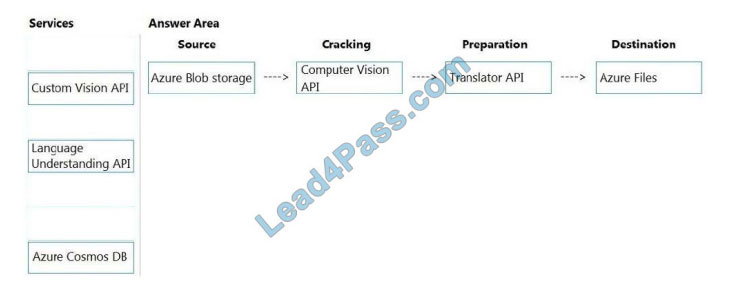
Box 1: Azure Blob storage
At the start of the pipeline, you have unstructured text or non-text content (such as images, scanned documents, or
JPEG files). Data must exist in an Azure data storage service that can be accessed by an indexer.
Box 2: Computer Vision API
Scenario: Provide users with the ability to search for the insight gained from the images, manuals, and videos associated with
the products.
The Computer Vision Read API is Azure\’s latest OCR technology (learn what\’s new) that extracts printed text (in
several languages), handwritten text (English only), digits, and currency symbols from images and multi-page PDF
documents.
Box 3: Translator API
Scenario: Product descriptions, transcripts, and all text must be available in English, Spanish, and Portuguese.
Box 4: Azure Files
Scenario: Store all raw insight data that was generated, so the data can be processed later.
Incorrect Answers:
The custom vision API from Microsoft Azure learns to recognize specific content in imagery and becomes smarter with
training and time.
NEW QUESTION 17:
You are developing a new sales system that will process the video and text from a public-facing website.
You plan to monitor the sales system to ensure that it provides equitable results regardless of the user\’s location or background.
Which two responsible AI principles provide guidance to meet the monitoring requirements? Each correct answer
presents part of the solution. (Choose two.)
NOTE: Each correct selection is worth one point.
A. transparency
B. fairness
C. inclusiveness
D. reliability and safety
E. privacy and security
Correct Answer: BD
AI systems should treat all people fairly.
AI systems should perform reliably and safely.
Reference:
https://docs.microsoft.com/en-us/azure/cloud-adoption-framework/strategy/responsible-ai
NEW QUESTION 18:
You deploy a web app that is used as a management portal for indexing in Azure Cognitive Search. The app is
configured to use the primary admin key.
During a security review, you discover unauthorized changes to the search index. You suspect that the primary access
key is compromised.
You need to prevent unauthorized access to the index management endpoint. The solution must minimize downtime.
What should you do next?
A. Regenerate the primary admin key, change the app to use the secondary admin key, and then regenerate the
secondary admin key.
B. Change the app to use a query key, and then regenerate the primary admin key and the secondary admin key.
C. Regenerate the secondary admin key, change the app to use the secondary admin key, and then regenerate the
primary key.
D. Add a new query key, change the app to use the new query key, and then delete all the unused query keys.
Correct Answer: A
Regenerate admin keys.
Two admin keys are created for each service so that you can rotate a primary key, using the secondary key for business
continuity.
1.
In the Settings >Keys page, copy the secondary key.
2.
For all applications, update the API key settings to use the secondary key.
3.
Regenerate the primary key.
4.
Update all applications to use the new primary key.
Note: Two admin API keys, referred to as primary and secondary keys in the portal, are automatically generated when
the service is created and can be individually regenerated on demand. Having two keys allows you to roll over one key
while using the second key for continued access to the service.
Reference: https://docs.microsoft.com/en-us/azure/search/search-security-api-keys#regenerate-admin-keys
NEW QUESTION 19:
You need to build a chatbot that meets the following requirements:
Supports chit-chat, knowledge base, and multilingual models Perform sentiment analysis on user messages Selects
the best language model automatically
What should you integrate into the chatbot?
A. QnA Maker, Language Understanding, and Dispatch
B. Translator, Speech, and Dispatch
C. Language Understanding, Text Analytics, and QnA Maker
D. Text Analytics, Translator, and Dispatch
Correct Answer: C
Language Understanding: An AI service that allows users to interact with your applications, bots, and IoT devices by
using natural language.
QnA Maker is a cloud-based Natural Language Processing (NLP) service that allows you to create a natural
conversational layer over your data. It is used to find the most appropriate answer for any input from your custom
knowledge base (KB) of information.
Text Analytics: my insights in unstructured text using natural language processing (NLP)–no machine learning
expertise required. Gain a deeper understanding of customer opinions with sentiment analysis. The Language Detection
feature of the Azure Text Analytics REST API evaluates text input
Incorrect Answers:
A, B, D: Dispatch uses sample utterances for each of your bot\’s different tasks (LUIS, QnA Maker, or custom), and
builds a model that can be used to properly route your user\’s request to the right task, even across multiple bots.
NEW QUESTION 20:
HOTSPOT
You develop a test method to verify the results retrieved from a call to the Computer Vision API. The call is used to
analyze the existence of company logos in images. The call returns a collection of brands named brands.
You have the following code segment.

For each of the following statements, select Yes if the statement is true. Otherwise, select No. NOTE: Each correct
selection is worth one point.
Hot Area:
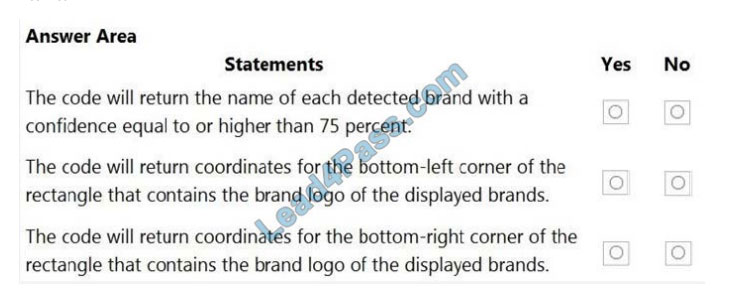
Correct Answer:
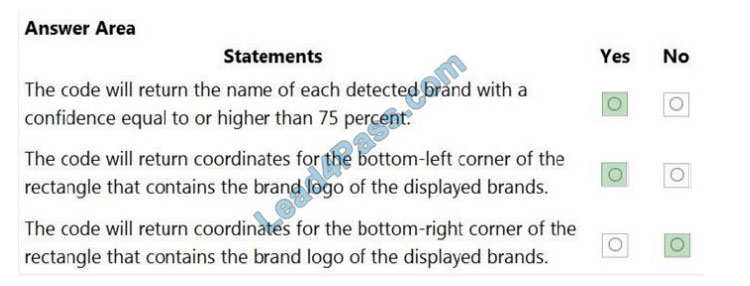
Box 1: Yes
Box 2: Yes
If several logs are detected, or the logo image and the stylized brand name are detected as two separate logos, it starts
numbering them from the bottom-left corner.
Box 3: No
Reference:
https://docs.microsoft.com/en-us/azure/cognitive-services/computer-vision/concept-brand-detection
NEW QUESTION 21:
DRAG DROP
You are using a Language Understanding service to handle natural language input from the users of a web-based
customer agent.
The users report that the agent frequently responds with the following generic response: “Sorry, I don’t understand
that.”
You need to improve the ability of the agent to respond to requests.
Which three actions should you perform in sequence? To answer, move the appropriate actions from the list of actions
to the answer area and arrange them in the correct order. (Choose three.)
Select and Place:
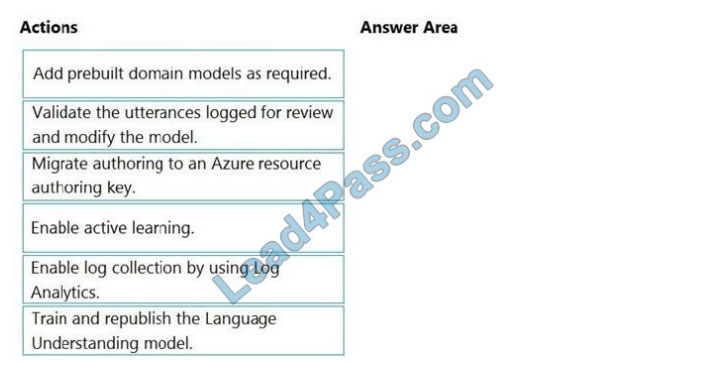
Correct Answer:
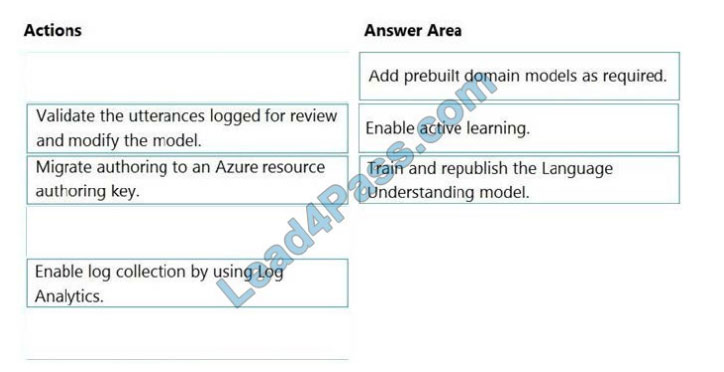
Step 1: Add prebuilt domain models as required.
Prebuilt models provide domains, intents, utterances, and entities. You can start your app with a prebuilt model or add a
relevant model to your app later.
Note: Language Understanding (LUIS) provides prebuilt domains, which are pre-trained models of intents and entities
that work together for domains or common categories of client applications.
The prebuilt domains are trained and ready to add to your LUIS app. The intents and entities of a prebuilt domain are fully customizable once you\’ve added them to your app.
Step 2: Enable active learning
To enable active learning, you must log user queries. This is accomplished by calling the endpoint query with the
log=true query string parameter and value.
Step 3: Train and republish the Language Understanding model
The process of reviewing endpoint utterances for correct predictions is called Active learning. Active learning captures
endpoint queries and selects user\’s endpoint utterances that it is unsure of. You review these utterances to select the
intent and mark entities for these real-world utterances. Accept these changes into your example utterances then train and
publish. LUIS then identifies utterances more accurately.
Incorrect Answers:
Enable log collection by using Log Analytics
Application authors can choose to enable logging on the utterances that are sent to a published application. This is not
done through Log Analytics.
Reference:
https://docs.microsoft.com/en-us/azure/cognitive-services/luis/luis-concept-prebuilt-model
NEW QUESTION 22:
HOTSPOT
You plan to deploy a containerized version of an Azure Cognitive Services service that will be used for text analysis.
You configure https://contoso.cognitiveservices.azure.com as the endpoint URI for the service, and you pull the latest
version of the Text Analytics Sentiment Analysis container.
You need to run the container on an Azure virtual machine by using Docker.
How should you complete the command? To answer, select the appropriate options in the answer area.
NOTE: Each correct selection is worth one point.
Hot Area:
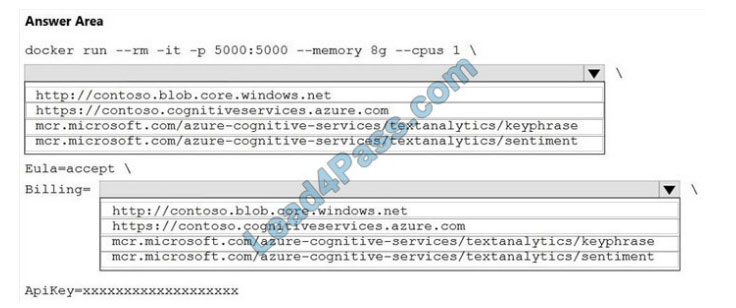
Correct Answer:
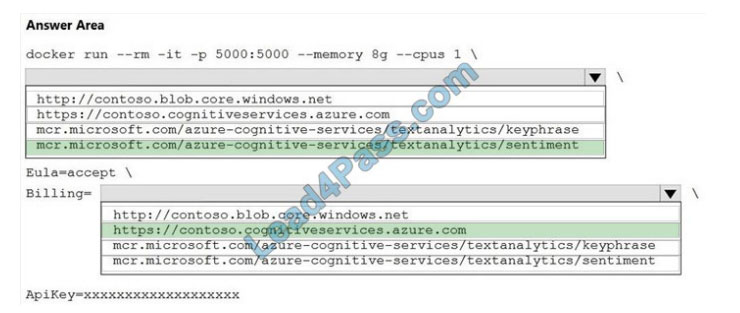
Box 1: mcr.microsoft.com/azure-cognitive-services/textanalytics/sentiment
To run the Sentiment Analysis v3 container, execute the following docker run command.
docker run –rm -it -p 5000:5000 –memory 8g –CPUs 1 \
mcr.microsoft.com/azure-cognitive-services/textanalytics/sentiment \
Eula=accept \
Billing={ENDPOINT_URI} \
ApiKey={API_KEY} is the endpoint for accessing the Text Analytics API. https://.cognitiveservices.azure.com
Box 2: https://contoso.cognitiveservices.azure.com
{ENDPOINT_URI} is the endpoint for accessing the Text Analytics API: https://.cognitiveservices.a The endpoint for accessing the Text Analytics API. zure.com
Reference:
NEW QUESTION 23:
You have a Video Indexer service that is used to provide a search interface over company videos on your company\’s
website.
You need to be able to search for videos based on who is present in the video.
What should you do?
A. Create a person model and associate the model with the videos.
B. Create person objects and provide face images for each object.
C. Invite the entire staff of the company to Video Indexer.
D. Edit the faces in the videos.
E. Upload names to a language model.
Correct Answer: A
Video Indexer supports multiple Person models per account. Once a model is created, you can use it by providing the
model ID of a specific Person model when uploading/indexing or reindexing a video. Training a new face for a video
updates the specific custom model that the video was associated with.
Note: Video Indexer supports face detection and celebrity recognition for video content. The celebrity recognition feature
covers about one million faces based on commonly requested data sources such as IMDB, Wikipedia, and top LinkedIn
influencers. Faces that aren\’t recognized by the celebrity recognition feature are detected but left unnamed. Once you
label a face with a name, the face and name get added to your account\’s Person model. Video Indexer will then
recognize this face in your future videos and past videos.
Reference: https://docs.microsoft.com/en-us/azure/media-services/video-indexer/customize-person-model-with-api
NEW QUESTION 24:
DRAG DROP
You plan to use a Language Understanding application named app1 that is deployed to a container.
App1 was developed by using a Language Understanding authoring resource named lu1.
App1 has the versions shown in the following table.

You need to create a container that uses the latest deployable version of app1.
Which three actions should you perform in sequence? To answer, move the appropriate actions from the list of actions
to the answer area and arrange them in the correct order. (Choose three.)
Select and Place:
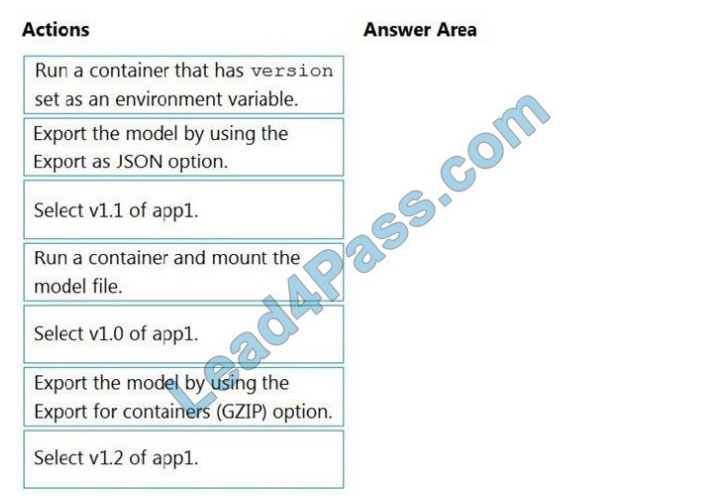
Correct Answer:
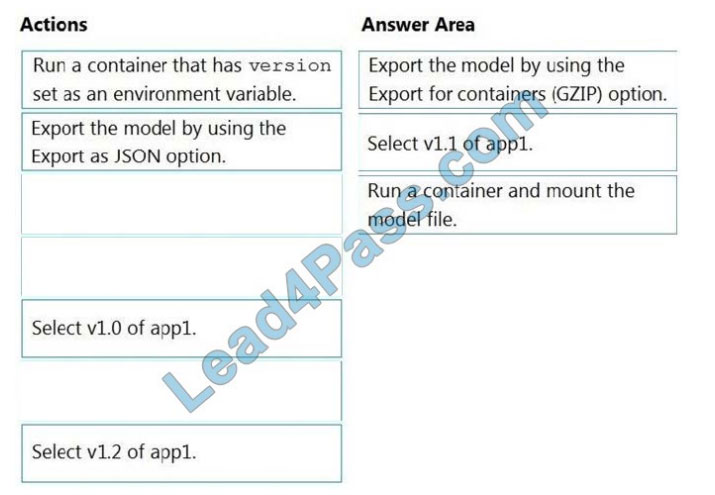
NEW QUESTION 25:
HOTSPOT
You are planning the product creation project.
You need to build the REST endpoint to create the multilingual product descriptions.
How should you complete the URI? To answer, select the appropriate options in the answer area.
NOTE: Each correct selection is worth one point.
Hot Area:

Correct Answer:

Box 1: api.cognitive.microsofttranslator.com Translator 3.0: Translate. Send a POST request to:
https://api.cognitive.microsofttranslator.com/translate?api-version=3.0
Box 2: /translate Reference: https://docs.microsoft.com/en-us/azure/cognitive-
services/translator/reference/v3-0-translate
NEW QUESTION 26:
HOTSPOT
You develop an application that uses the Face API.
You need to add multiple images to a personal group.
How should you complete the code? To answer, select the appropriate options in the answer area.
NOTE: Each correct selection is worth one point.
Hot Area:
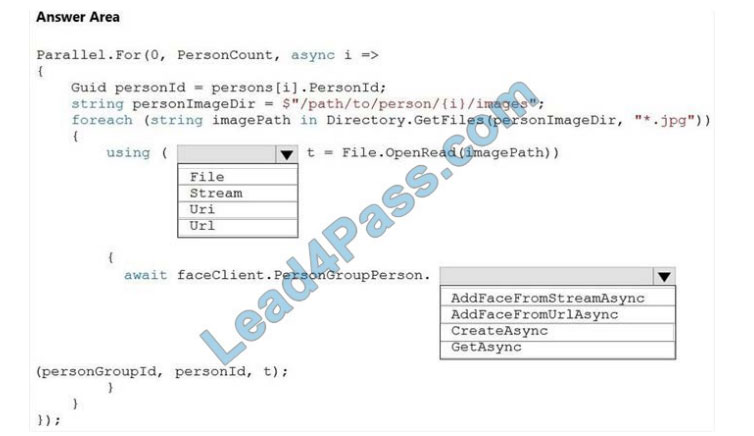
Correct Answer:
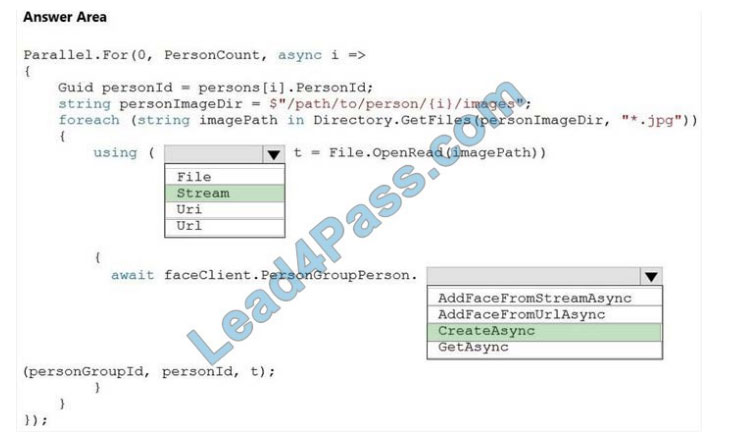
Box 1: Stream
The File.OpenRead(String) method opens an existing file for reading.
Example: Open the stream and read it back. using (FileStream fs = File.OpenRead(path))
Box 2: CreateAsync
Create the persons for the PersonGroup. Persons are created concurrently.
Example:
await faceClient.PersonGroupPerson.CreateAsync(personGroupId, personName);
…
leads4pass updates Microsoft AI-102 exam questions and answers throughout the year and frequently shares a selection of free exam questions and answers, as shown above, candidates can improve themselves through online learning.
Also able to download the latest AI-102 dumps: https://www.leads4pass.com/ai-102.html (Dumps PDF+VCE) to help them successfully pass the AI-102 Designing and Implementing a Microsoft Azure AI Solution (beta) certification exam on their first attempt.
By the way, download the above AI-102 PDF study materials for free:https://drive.google.com/file/d/1RuAMXB1Kk-cbvCIuycZCBaUv7mu0SFq1/